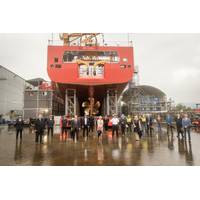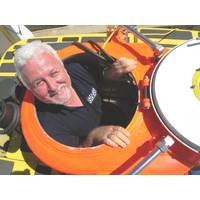
Video: Seaspan Shipyards Launches CCGS John Cabot
Vessels (OFSV) for the Canadian Coast Guard.The 63.4-meter CCGS John Cabot will next undergo sea trials before its delivery to the Coast Guard later this summer. The vessel will be based in St. John’s, Newfoundland and Labrador.CCGS John Cabot and previously delivered sister ships, CCGS Sir John Franklin, now stationed in Victoria, British Columbia, and CCGS Capt Jacques Cartier, stationed in Dartmouth, Nova Scotia, are the first class of ships built under the National Shipbuilding Strategy (NSS), the Government of Canada’s strategy to renew the fleets of the Canadian Coast Guard and Royal
CCG Adds OFSV to its Fleet
. Jacques Cartier, the Canadian Coast Guard’s newest state-of-the-art Offshore Fisheries Science Vessel (OFSV), the second OFSV delivered by Seaspan."The milestone in the shipbuilding process took place exactly five months and two days after the delivery of her sister ship, the CCGS Sir John Franklin. These two ships are the first large vessels delivered under the National Shipbuilding Strategy, the Government of Canada’s plan to renew the federal fleet with ships built in Canada for Canadians," said a press note.In addition to major partners like Thales Canada who are responsible

Seaspan-Built CCG Ship Heads for Sea Trials
vessel to the Coast Guard later this year, which will enable them to do their critical work focused on the protection, preservation and conservation of Canada’s coastal waters.”This milestone on the second OFSV follows her launch on June 5 and the delivery of the first OFSV, the CCGS Sir John Franklin, on June 27. The CCGS Sir John Franklin is the first large vessel to be built and delivered under the National Shipbuilding Strategy.Given the important scientific work to be performed by the OFSV Class, specific attention is also given during Sea Trials to the extensive array of ship sensors
Seaspan Delivers Canada's First OFSV
Seaspan Shipyards has delivered Canada's first new Offshore Fisheries Science Vessels (OFSV), the CCGS Sir John Franklin, to the Canadian Coast Guard (Coast Guard).An official handover ceremony took place aboard the vessel attended by the Minister of Fisheries, Oceans and the Canadian Coast Guard, senior officials from the Coast Guard, Seaspan and supply chain partners.The delivery of the first OFSV is the culmination of years of work by hundreds of dedicated Seaspan employees and supply chain partners from across Canada.As the first large vessel to be built and delivered to the Government of

Kraken Set to Hunt for Avro Arrow Artifacts
, search area size and the amount of metal debris on the bottom. According to military records, more than 600 missiles were launched from the same site, which was also used as an artillery range in the 1930s. This summer's search for the Avro Arrow models can be likened to the hunt for Sir John Franklin's lost ships. The first vessel – the HMS Erebus – was discovered in September 2014 by a Canadian expedition team that included participation by Kraken engineers and its AquaPix SAS technology. However, the Arrow models are far smaller targets. While the full-size Arrow measured 24
All Hands on Deck: ROVs and AUVs Aid Search for Franklin
route through the Arctic Ocean unpredictable and, on occasions, virtually impassable. Yet, since the 1500s the promise of connecting the Atlantic and Pacific Oceans, and the economic benefits which would follow, were enough to entice many expeditions into this treacherous pass. One such explorer, Sir John Franklin, set sail in 1845 from England with his crew on board HMS Erebus and HMS Terror, vanishing almost without a trace. In September 2014, more than 170 years on, search expeditions led by Parks Canada discovered the wreck of HMS Erebus and two years later, HMS Terror was found. While advancements

View from the Top: Dr. James Delgado, NOAA Director of Maritime Heritage
Other than archaeological traces, they are gone but not forgotten. Of course, there are a number of things going on all the time with many of my colleagues around the world such as the team at Parks Canada and their ongoing work with HMS Erebus (one of two historic ships British explorer Sir John Franklin sailed to find the Norwest Passage in 1845; Franklin and his crew eventually died after the ships became ice-locked) to Hunley (an American Civil War submarine that made history as being the first sub to sink a war ship; her crew and the vessel disappeared shortly afterward). As the rust continues
Second Ship of Franklin Arctic Voyage Found, Canada Confirms
of the wreckage from the journey through Canada's Northwest Passage. Britain's Guardian newspaper reported earlier this month that the Arctic Research Foundation, a private group participating in the search effort, had found the ship in pristine condition at the bottom of a bay. Sir John Franklin and his 128-member crew on the Terror and HMS Erebus all died after the vessels became stuck in ice during a search for the fabled Arctic passage between the Atlantic and Pacific oceans. The fate of the ships remained one of the great mysteries in Canadian history for almost 170 years

Second Ship Found from Doomed 1800s Arctic Expedition
to Canada's Arctic Northwest Passage, Britain's Guardian newspaper said on Monday. The Arctic Research Foundation, a private group that sent a vessel to help look for the ship, found it in pristine condition at the bottom of a bay earlier this month, a spokesman told the paper. Sir John Franklin and his 128-member crew in the Terror and HMS Erebus all died after the vessels became stuck in ice during a search for the fabled Arctic passage between the Atlantic and Pacific oceans. The fate of the ships remained one of the great mysteries in Canadian history for almost 170 years



 February 2024
February 2024





